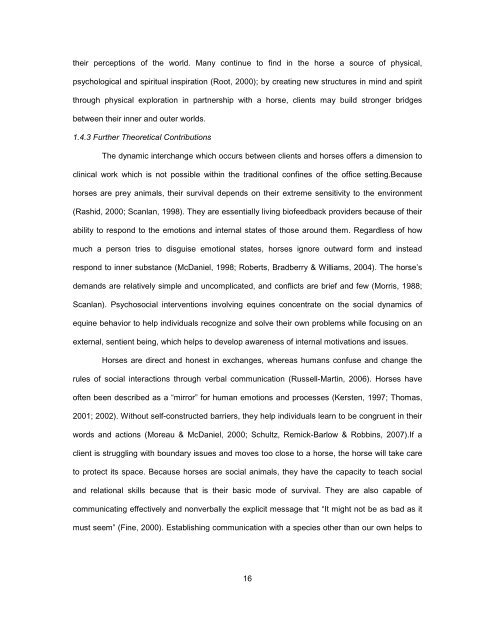A SYSTEMATIC REVIEW OF THE EFFECTS OF PSYCHOTHERAPY ...
A SYSTEMATIC REVIEW OF THE EFFECTS OF PSYCHOTHERAPY ...
A SYSTEMATIC REVIEW OF THE EFFECTS OF PSYCHOTHERAPY ...
Create successful ePaper yourself
Turn your PDF publications into a flip-book with our unique Google optimized e-Paper software.
their perceptions of the world. Many continue to find in the horse a source of physical,<br />
psychological and spiritual inspiration (Root, 2000); by creating new structures in mind and spirit<br />
through physical exploration in partnership with a horse, clients may build stronger bridges<br />
between their inner and outer worlds.<br />
1.4.3 Further Theoretical Contributions<br />
The dynamic interchange which occurs between clients and horses offers a dimension to<br />
clinical work which is not possible within the traditional confines of the office setting.Because<br />
horses are prey animals, their survival depends on their extreme sensitivity to the environment<br />
(Rashid, 2000; Scanlan, 1998). They are essentially living biofeedback providers because of their<br />
ability to respond to the emotions and internal states of those around them. Regardless of how<br />
much a person tries to disguise emotional states, horses ignore outward form and instead<br />
respond to inner substance (McDaniel, 1998; Roberts, Bradberry & Williams, 2004). The horse’s<br />
demands are relatively simple and uncomplicated, and conflicts are brief and few (Morris, 1988;<br />
Scanlan). Psychosocial interventions involving equines concentrate on the social dynamics of<br />
equine behavior to help individuals recognize and solve their own problems while focusing on an<br />
external, sentient being, which helps to develop awareness of internal motivations and issues.<br />
Horses are direct and honest in exchanges, whereas humans confuse and change the<br />
rules of social interactions through verbal communication (Russell-Martin, 2006). Horses have<br />
often been described as a “mirror” for human emotions and processes (Kersten, 1997; Thomas,<br />
2001; 2002). Without self-constructed barriers, they help individuals learn to be congruent in their<br />
words and actions (Moreau & McDaniel, 2000; Schultz, Remick-Barlow & Robbins, 2007).If a<br />
client is struggling with boundary issues and moves too close to a horse, the horse will take care<br />
to protect its space. Because horses are social animals, they have the capacity to teach social<br />
and relational skills because that is their basic mode of survival. They are also capable of<br />
communicating effectively and nonverbally the explicit message that “It might not be as bad as it<br />
must seem” (Fine, 2000). Establishing communication with a species other than our own helps to<br />
16
















